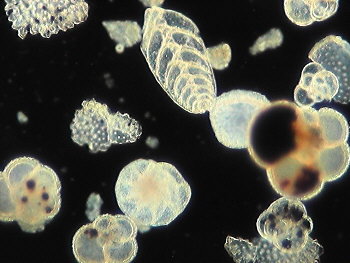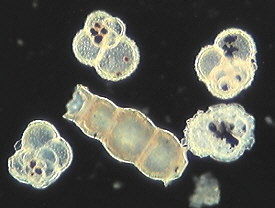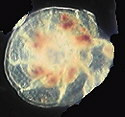 |
(The Foraminifera) by Brian Darnton, UK |
 |
 |
(The Foraminifera) by Brian Darnton, UK |
 |
 Ninety odd
million years ago the chalk downland of Northern Europe was ooze
at the bottom of a great sea. Strange creatures lived on the
marine debris that showered down from the upper layers of the
ocean. Their bodies were made of chalk extracted from the rich
sea-water. As they died, so a deep layer built up, and slowly it
became consolidated into rock.
Ninety odd
million years ago the chalk downland of Northern Europe was ooze
at the bottom of a great sea. Strange creatures lived on the
marine debris that showered down from the upper layers of the
ocean. Their bodies were made of chalk extracted from the rich
sea-water. As they died, so a deep layer built up, and slowly it
became consolidated into rock.

 Collection.
Collection.Cliffs are dangerous places, but look out for sites where the chalk subsoil shows through the turf. Mole hills often contain nodules of soft chalk.
 The most
effective method is to place the nodules in a wet cloth bag and
thump them with a hammer.Then the white slurry can be washed
through a 120 micron filter to take out the lumps of unbroken
material then pour the milky liquid through a 25 micron filter to
retain the shells and allow minute broken fragments to escape.
The residue is washed in water until the liquid runs clear.A
sample of material retained by the sieve can be taken with a
pipette and a strew can be made on a microscope slide. Its a good
idea to include a minute amount of fluid Gum Tragacanth which
will hold the strew during and after mounting.
The most
effective method is to place the nodules in a wet cloth bag and
thump them with a hammer.Then the white slurry can be washed
through a 120 micron filter to take out the lumps of unbroken
material then pour the milky liquid through a 25 micron filter to
retain the shells and allow minute broken fragments to escape.
The residue is washed in water until the liquid runs clear.A
sample of material retained by the sieve can be taken with a
pipette and a strew can be made on a microscope slide. Its a good
idea to include a minute amount of fluid Gum Tragacanth which
will hold the strew during and after mounting.
 Observation.
Observation.Mounted in Numount the shells are best seen in plain transmitted light using a X10 objective lens. You will see not only examples of the Foraminifera but also pieces of sponge and other marine debris. Different chalk formations can be compared and noted.
Comments to the author Brian Darnton welcomed.
****************
Editor's notes
Brian prepares and sells a selected range of strewn and type microscope slides of foraminifera. Visit Brian's Home Pages for details.
Images by Dave Walker using Russian planachromatic 9x (N.A. 0.20) objective and dark-field illumination with home-made patch stop from slide prepared by Brian. The slide is a strew of washings from Miocene clay 10 million years B.P. from Malta, Ghajn Tuffeha bay.
In the UK slide preparation materials such as Gum Tragacanth and Numount are available from Northern Biological Supplies.
Read Micscape article Making dark-field illumination is easy is easy.
First published in July 1998 Micscape Magazine.
Please report any Web problems
or offer general comments to the Micscape Editor,
via the contact on current Micscape Index.
Micscape is the on-line monthly
magazine of the Microscopy UK web
site at Microscopy-UK